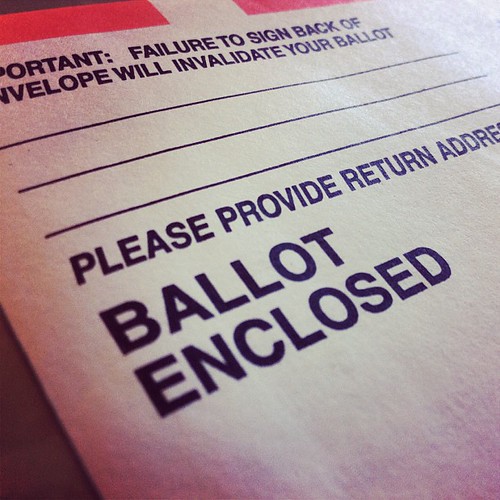By Alexander Egber.
It’s hard to find a more contentious issue in American politics today than voting rights. Most of the media’s attention on the topic has justifiably focused on the current Congress’s effort to pass federal voting rights legislation that would supersede the Supreme Court’s much-discussed decisions in Shelby County v. Holder and Brnovich v. Democratic National Committee. These decisions chipped away at the potency of the Voting Rights Act of 1965 and presumably made it more difficult to challenge voting laws by arguing they have a racially disparate impact.
Legal challenges to voting laws come in other flavors as well, though. Another prominent legal theory that election litigators use is that a law violates equal protection under the Fourteenth Amendment. That’s the precise theory the Arizona Democratic Party relied on in 2020 when it contested an Arizona voting regulation relating to signature verification for mail-in ballots. The Ninth Circuit recently considered the regulation’s constitutionality in Arizona Democratic Party v. Hobbs, and the opinion is instructive in exploring how courts analyze these constitutional challenges. First, let’s look at the framework the court applied.
The Anderson-Burdick Test
The Supreme Court set out to resolve the inherent tension between the fundamental importance of voting access and the state’s duty to regulate elections in a pair of cases in 1983 and 1992. In Anderson v. Celebrezze and Burdick v. Takushi, the Supreme Court recognized that an election law of any kind necessarily imposes a burden of some degree on the voter, and it reasoned that a strict scrutiny standard of review for every election law was unworkable.
Instead, the Supreme Court developed a more flexible balancing test between the government’s asserted interests and the burden on the voter. The demanding strict scrutiny standard is only used for a “severe” burden. Otherwise, the Anderson-Burdick Test provides a sliding scale approach: the less significant the burden, the more relaxed the scrutiny. The Ninth Circuit panel used this framework to analyze the Arizona law in Hobbs.
Arizona Democratic Party v. Hobbs
Arizona law allows all voters to vote by mail. To do so, a voter must return a completed ballot in an envelope with a signed affidavit. Additionally, the signature on the affidavit must match the signature in the voter’s registration. At the time of the lawsuit, Arizona statute A.R.S. § 16-550(A) permitted voters an additional three or five business days (the latter when a federal office is on the ballot) after an election to cure a mismatched signature. No such statutory provision existed for a missing signature.
The Secretary of State, with the approval of the Governor and Attorney General, promulgates the Election Procedures Manual prescribing guidelines for election officials to follow. The current manual, published on December 20, 2019, incorporated A.R.S. § 16-550(A) to permit voters additional time to cure a mismatched signature. However, the manual made election day the deadline for a missing signature. Plaintiffs alleged that this divergence violated the First and Fourteenth Amendment and denied procedural due process.
Writing for the majority, Judge Graber used the two-step Anderson-Burdick Test to analyze the voting law. In the first step, the court found the burden on the voter to be minimal. Asking the voter to either sign the affidavit at the outset or to cure the error by the election day deadline was reasonable, Graber said. Further, she asserted that “the law here neutrally and nondiscriminatorily applies to all voters equally.”
Graber then turned to the second step of the Anderson-Burdick Test and merely scrutinized the government’s interest under a standard akin to rational basis review. Here, the State argued that the election day deadline furthered its interest in minimizing administrative burdens on poll workers. The Court concluded that even this small burden was enough to satisfy the Anderson-Burdick Test, and the Ninth Circuit correspondingly upheld the Arizona law.
The Impact of Hobbs
Hobbs is important for several reasons. First, the decision may have a direct effect on the upcoming 2022 election. Voters should be aware of the requirement to sign the affidavit on a mail-in ballot and be aware of the deadline to cure a missing or mismatched signature. The deadlines will remain the same going forward — A.R.S. § 16-550(A) was amended in 2021 to expressly state the election day deadline for missing signatures that was previously omitted.
Second, Hobbs exemplifies a fickle legal test that needs further clarification by the Supreme Court. The test gives both legislators and judges too much discretion in their analysis of potentially restrictive voting regulations. Indeed, a circuit split has emerged following the Supreme Court’s splintered 2008 plurality opinion in Crawford v. Marion County, the Court’s only case to apply the Anderson-Burdick Test. The circuit split, along with an unworkable legal standard, makes this issue particularly ripe for Supreme Court review, especially while legal challenges to election laws only continue to proliferate.
If the Supreme Court does decide to revisit Anderson-Burdick, lower courts, at minimum, need better-defined guidance on how to analyze election challenges. The most likely outcome, in my view, would be a repudiation of the amorphous Anderson-Burdick Test and a transition towards a legal standard that is highly deferential to the states. Perhaps a more radical outcome would be preferable, however, by replacing the framework with an entirely alternative approach that focuses on the singular question of partisan legislative intent. In any event, enhanced legal stability and predictability than are currently provided by Anderson-Burdick are highly desirable in today’s litigious environment.

